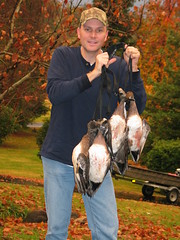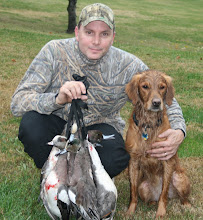"What is today's date?"
"I don't know, November 20th I think."
"Are Specks open?"
"I'm not sure. I think they closed on November 10th."
"I thought they opened on November 10th and closed December 31st?"
"Oh, right, I think that's it."
Meanwhile, the Specks are working like magic and they continue their playful dips and dives getting closer to gunning range.

"Are you Sure?!"
"No."
"No! Dang it, get out your reg book."
"I don't have one, do you?"
Specks are now hovering over the decoys at 15 yards getting more and more suspicious of their motionless mates down below.
"NO! Quick, do you have your cell phone? Call Andy over at the sporting goods store and ask him if Specks are open."
"It's 6:30am, Andy ain't there."
"AArrrggg...."
The Specks now tire of toying with our emotions and lazily float off into the horizon. Silence now abounds in the blind. Finally, The Hunting Partner squeaks out, "Found my reg book..."
Now some of you might say that it is our fault for not having thoroughly read and memorized the waterfowl hunting regulations for the current season. But I actually pride myself on having a photographic memory and am a good steward for reading and understanding the rules of the field before stepping foot out of the truck. But these days, it seems as though you need a Ph.D. in multidisciplinary linguistic composition (yes, I did look that up) to understand the comings and goings of the hunting regulations.
I did some quick 'research' on the internet and found two similar hunting regulations - one from the current 2008/09 waterfowl season that were recently set by the US Fish & Wildlife Service; and the same regulations from 1957.
2008/09 Central Flyway Regulations
In Montana, Nebraska, Colorado, Oklahoma, and New Mexico, the daily bag limit would be 6 ducks, with species and sex restrictions as follows: mallard -- five, no more than two of which may be females; redhead, scaup, wood duck -- two; pintail, mottled duck, canvasback -- one. For pintails and canvasbacks, the season length would be 39 days, which may be split according to applicable zones/split duck hunting configurations approved for each state. The possession limit would be twice the daily bag limit. In North Dakota, South Dakota, Wyoming, Kansas, and Texas, the daily bag limit would be five ducks, with species and sex restrictions as follows: scaup, redhead and wood duck -- two; only one duck from the following group -- hen mallard, mottled duck, pintail, canvasback. The possession limit would be twice the daily bag.
Contrast this to the 1957 Central Flyway Regulations
The season shall be 75 days, beginning October 1st and ending no later than January 15th. The daily bag limit is 5 with species and sex restrictions as follows: H. Merganser -- one, wood duck -- one. There was also one footnote at the bottom of the table indicating that states choosing a split season would be penalized 10%.
 Point made. If I were hunting in any of the states which are articulated in the current regs, I would be extremely nervous about accidental harvest without undertaking a rigorous study of the rules. Even with that, I would keep Andy's phone number on speed dial.
Point made. If I were hunting in any of the states which are articulated in the current regs, I would be extremely nervous about accidental harvest without undertaking a rigorous study of the rules. Even with that, I would keep Andy's phone number on speed dial. My issue with all this increasing regulatory complexity is that, at least for waterfowl hunting, biologists have been telling us for years that harvest does not negatively impact population levels. Rather, nesting and brooding habitat are the most important factors in determining species success. The current regulatory scheme certainly doesn't support that theory. So why all the complex slicing and dicing by state, species, dates, regions within states, etc., etc.?
When looking at the long term waterfowl population averages, there is further compelling evidence that increasing the detailed breakout of harvest regulations by state and species restriction hasn't necessarily helped increase populations. Pintails are the shining example of this theory. Pintails have been restricted to one for years and still no recovery.
I'm a pretty simple man, hopefully not simple minded, but simple in practice. I enjoy our wildlife resources like most of you and do what I can to help promote and fund their thriving in our wild lands. I play by the rules when I am in the field and trust that the scientists that study wildlife and set those rules have done so with the wildlife's best interest at heart. I just wish that it didn't have to be so dang hard.


7 comments:
the bad part is when it's 6:30 so Andy isn't in and you brought your reg book with you but it fell out of your blind bag, landed in the marsh and now is unreadable... or the dog stole it when you weren't looking and ate it... or when you grab your regs book to check something and realize that you picked up the fishing regs book off the end table not the waterfowl regs book
yep, been there, done that :) oh and in our state you have to know what zone you are in too because the rules are different for different zones and we hunt a couple different zones...
I do feel like I need some sort of college course in order to understand all the hunting regulations we have. We are separated by zones as well, for deer hunting, not even for duck hunting (I'm not sure if that has zones or not. I don't duck hunt). It can definitely be painful sometimes to understand.
It is like taxes sometimes too--just when you figure out the rules they make a change and you have to start all over again.
It would be nice to have it a bit more simplistic, but I'm afraid that that just isn't going to happen.
We will just have to suck it up, play by the rules like we do, and hope that the blow dryer will dry the regs well off so that we can eventually read them again.
It does sound very confusing. It's also kind of sad that hunters often get a bad rap for not obeying the law and all the while hunters are sitting in blinds agonizing over whether or not the shot they want to take is legal.
WA state's fishing regs are near indecipherable. There's a sad subtext: with declining anadromous fish runs and ESA listed species, the fish need to be carefully managed down to the single digit so we can still have a season; the alternative is closed waters.
Here's a thought: I know a lot of under-employed English majors who could iron out the semantics...
That was great - an entertaining way of bringing to light a good point. And I'm sure impressed with the multilanguistic whatever...whether you looked it up or not!
I agree that it seems they could really stand to simplify the reg severely. When it comes to big game hunting - I hate the point restrictions rules - they will break it up within a unit - like 'this unit is open to all hunting, except for that portion from Bob's Hill to Timmy's Draw - that portion is 3 point only except if it has velvet on it's horns in which case it is four point only unless it is a non-typical in which case it's 6 on one side 4 1/2 on the other only....and so on. Ridiculous.
Right you are! Each year it is more difficult to cipher. I keep a cheat sheet taped to the outside of my license holder with the basic season dates and species specific limits. So far it has worked when my memory failed. Easier than carrying the entire synopsis.
I know hunters that have put away their guns because of all the micro regulating, and you know, I can understand their perspective.
I keep cheat sheets to - a summary regs card, the full regs book and two ID books.
Still, I'm a bit freaked this year that we get ZERO canvasbacks. I've shot one can, and I can tell you I didn't know it was a can until I picked it up. I can ID birds I see a lot of, but I'm scared to death of that one
Post a Comment